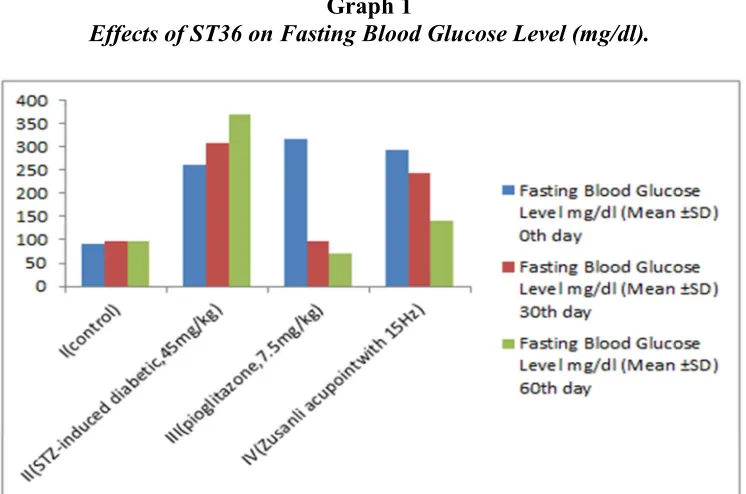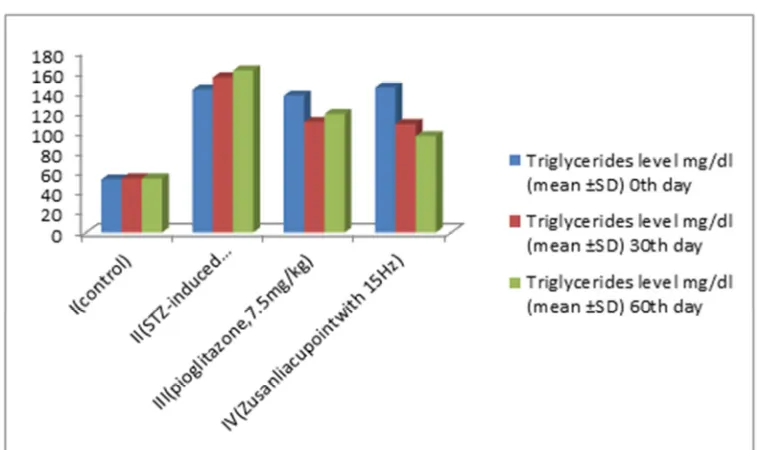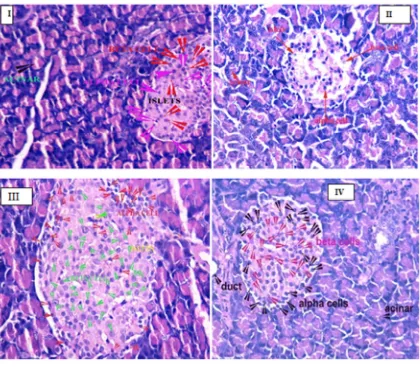Original Research Article Histology
International Journal of Life science and Pharma Research ISSN 2250-0480
MICROANATOMICAL CHANGES OF PANCREAS WITH EFFECT OF
ACU-TENS AT ZUSANLI (ST36) ACUPOINTS IN STREPTOZOTOCIN INDUCED
DIABETIC RATS
SUBBULAKSHMI1*, GIRIJA SIVAKUMAR2 AND SATHIYA NARAYANA MURTHY3
1
Research scholar, Bharath University, Reader, Department of Anatomy,
Vivekanandha Dental College for Women, Tiruchengode, Namakkal (dt),Tamilnadu, India.
2
Department of Anatomy, Karpaga Vinayaga Institute of Medical Sciences, Maduranthagam, Chennai, Tamilnadu, India.
3
Department of Anatomy, Vivekanandha Dental College for Women, Tiruchengode, Namakkal (dt),Tamilnadu, India.
ABSTRACT
Acupuncture is an alternative and complementary medicine used throughout the World to treat various chronic disorders including diabetes. The aim of this present study is to explain the hypoglycemic effect of non-invasive stimulation with Acu-TENS at bilateral Zusanli (ST36) acupoints in Streptozotocin(45 mg /kg / body weight / IP) induced diabetic rats. The Acu - TENS therapy was given with low frequency 15 HZ, high intensity and width of 5 sec pulse at the Zusanli(ST36) acupoints in diabetic induced rats for 5 minutes every day without anaesthesia for 60 days. A more steady significant (p ≤ 0.01) decrease in fasting blood glucose level was noted in Zusanli acupoints treated diabetic rats and compared with antidiabetic drug (pioglitazone,7.5 mg / kg /body weight) treated rats.The acupuncture treated diabetic rats showed more significant (p ≤ 0.01) decrease in total cholesterol, triglycerides, low density lipid and significant increase in high density lipid.Histopathological examination of pancreas in Zusanli acupoints treated diabetic rats showed near normal architecture and regular shaped islets with regeneration of cells and compared with anti-diabetic drug treated rats pancreas. Stimulation at ST36 acupoints produced antidiabetic effects and improved lipid metabolism may be due to increase in insulin secretion through the mediation of β- endorphin and stimulation of Qi (energy flow) and utilisation of energy due to mild muscle twitching during stimulation.
KEY WORDS: Zusanli, Acupoint, ST36, Acu-TENS,Pancreas,Diabetes,Streptozotocin
Received on: 11-02-2019
Revised and Accepted on: 11-03-2019
DOI: http://dx.doi.org/10.22376/ijpbs/lpr.2019.9.2.L7-15
SUBBULAKSHMI*
Research scholar, Bharath University, Reader, Department of Anatomy, Vivekanandha Dental College for Women,
INTRODUCTION
Diabetes is a chronic disorder characterized by altered metabolism in carbohydrates, fats and proteins with increased blood sugar levels. Macrovascular diseases (coronary heart disease and peripheral arterial disease) and microvascular diseases (retinal and renal vascular disease) are the long term complications of diabetes mellitus1. The Worldwide prevalence of diabetes will expect to increase from 4% in 1995 to 5.4% by the year 20252 and will become a growing threat to global health3. In India, diabetes is gaining the status of a potential epidemic disease4,5 and becoming the diabetes capital of the World with a projected 109 million people with diabetes by 20354. Type 2 diabetes (NIDDM), a common type of diabetes, adult-onset with the age group of > 40 years, occurs due to combination of insulin resistance and with reduced insulin secretion. Obesity and physical inactivity is the leading risk factors for type 2 diabetes. Though there is an effective pharmacological management due to some adverse effects of certain drugs, the researchers searched for complementary and alternative medicines to treat diabetes with no side effects and also to prevent its complications. Acupuncture, one of the oldest traditional medicines, is nowadays practice throughout the world mainly in U.S, Japan, Korea and India7. The therapeutic effects of acupuncture for diabetes have observed in several studies both experimentally and clinically to reduce symptoms and to prevent complications. According to the theory of traditional medicine, health is a state of balance between yin, yang, Qi, and five elements (metal, wood, water, fire and earth). Qi (life energy) flows within our body through a hypothesized channel called meridians with several acupoints. The ill health or disease in a body occurs due to imbalance in yin and yang, can be corrected with the stimulation of acupoints present along the meridians. Each acupoint has its different therapeutic action. The acupoints can be stimulated either manually using needle or electrically8. Acupuncture therapy in diabetes acts on the receptors of pancreas beta cells to increase the insulin secretion, promotes glucose metabolism and reduce the blood sugar level9. Several studies explained the beneficial effect of acupuncture on obesity, a major risk factor for type 2 diabetes and also various therapeutic effect of acupuncture on different system10. In our study, we selected bilateral Zusanli (ST36) acupoint for the treatment of diabetes based on traditional Chinese medicine11.
In this study, we used transcutaneous electric nerve stimulation at acupoints (Acu-TENS) therapy, a non-invasive method to stimulate the selected acupoints. This study mainly designed to investigate the antihyperglycemic effect of Zusanli (ST36) acupoint and was proved with the evidence of the histological changes in the pancreatic islets and biochemical parameters (fasting blood glucose level and lipid profile) in Streptozotocin - induced diabetic rats and acupuncture treated diabetic rats.
MATERIALS AND METHODS
Animal
Male albino wistar rats (200 - 250 gm) were selected for the study. The experimental rat in the animal house was maintained with well ventilation and at a controlled temperature with 12 hours light and dark cycles. The standard laboratory diet and water with ad libitum was given to the animals. The fasting blood glucose, food and water intakes of the rats were periodically measured and compared. This study was approved by Institutional Animal Ethical Committe(Reg.no,889/po /ac /05 / CPCSEA /2011) of Swamy Vivekanandha College of Pharmacy, Elayampalayam, Tiruchengode.
Study design
Histopathological changes in the pancreatic islets was assessed and compared between the groups. All animals were euthanized by over dose anaesthesia at the end of the treatment, for histopathological observation, the pancreatic tissue specimens were collected and fixed in 10 %
formalin, dehydrated in gradual ethanol (50 - 100%), cleared in xylene and embedded in paraffin sections (4 - 5µ) were prepared, stained with Heamatoxylin and Eosin . The body weight, water and food intake of all rats were also measured.
Figure 1
Zusanli(ST36)acupoints was stimulated with Acu-TENS of low- frequency(15HZ), High intensity and the pulse width of 5 sec,for 5 minutes daily without anaesthesia for 60 days.
STATISTICAL ANALYSIS
The results were expressed as mean ± SD and SE. The fasting blood glucose level were analysed by one-way ANOVA followed by Tukey post hoc test.The value of p ≤ 0.01 was considered asstatistically significant.
RESULTS
A steady decrease and significant (p ≤0.01) reduction of fasting blood glucose was observed in
Zusanli (ST36) acupoint and oral anti-diabetic drug (pioglitazone,7.5mg / kg / body weight) treated diabetic rats after 60 days of treatment. The Zusanli (ST36) acupoints stimulation restored its body weight. Graph1 shows fasting blood glucose level, Table-1, Graph -2, Table -2 and 3 show total cholesterol, triglycerides, high density lipid and low density lipid level. Diabetic rats treated with drug and Zusanli acupoint stimulation showed significantly (p ≤ 0.01) steady decrease in the total cholesterol, triglycerides, low density lipid and with significant (p ≤ 0.01) increase in high density lipid.
Graph 1
Effects of ST36 on Fasting Blood Glucose Level (mg/dl).
Table 1
Effect of acupuncture on total cholesterol of normal and Streptozotocin - induced diabetes rats
Groups Total cholesterol level mg/dl (mean ±SE)
0th day 30th day 60th day
I(control) 87.33±2.679 91.50±3.085 96.67±3.018 II(STZ-induced diabetic,45mg/kg) 148.50±4.169 169.17±4.028 189.83±3.868
III(pioglitazone,7.5mg/kg) 156.83±3.664 132.67±3.190 96.83±2.286 IV(Zusanli acupoint with 15Hz) 155.33±3.827 120.83±13.484 120.50±2.604
The results were expressed as Mean± SE. Comparison was done with one way ANOVA and Tukey test with (p≤0.01) to control and diabetic group.
Graph 2
Effect of acupuncture on triglycerides of normal and Streptozotocin -induced diabetes rats
The results were expressed as Mean± SD. Comparison was done with one way ANOVA and Turkey Test with (p≤0.01) to control and diabetic group.
Table 2
Effect of acupuncture on HDL of normal and Streptozotocin -induced diabetes rats
Groups HDL level mg/dl (mean ±SE)
0th day 30th day 60th day
I(control) 47.83±1.869 48.83±1.682 50.5±1.432 II(STZ-induced diabetic,45mg/kg) 33±2.324 24.83±2.982 20.33±1.783
III(pioglitazone,7.5mg/kg) 27±2.309 43.33±1.606 52.17±0.792** IV(Zusanli acupoint with 15Hz) 27.5±2.232 35±1.880 41.5±1.408**
Table 3
Effect of acupuncture on LDL of normal and Streptozotocin -induced diabetes rats
Groups LDL level mg/dl (mean ±SE)
0th day 30th day 60th day
I(control) 30.48±4.276 31.9±3.802 37.97±3.117 II(STZ-induced diabetic,45mg/kg) 86.93±5.728 96.87±18.617 137.3±4.807 III(pioglitazone,7.5mg/kg) 102.5±4.365 67.37±3.583 28.87±2.268** IV(Zusanli acupoint with 15Hz) 99±4.779 77.53±4.794 59.73±3.169**
The results were expressed as Mean± SE. Comparison was done with one way ANOVA and Tukey test with (p≤0.01) to control and diabetic group.
Histopathological examination
The group I control rats showed normal rounded or spherical shaped islets with different types of cells with capillaries, markedly separated by exocrine part made of closely packed acinar cells. In Group II, Streptozotocin induced diabetic rats; pancreas showed reduced size of islets with decrease in cellular density, numerous vacuoles and with degenerative changes in exocrine part. The pioglitazone treated group III rats showed near normal architecture of lobules with irregular shaped
islets with increase in cellular density and reduced number of vacuoles. Zusanli acupoints treated group IV rats showed recovery of near normal architecture of pancreas with regular shaped islets, increase in cellular density and reduced vacuole and compared with the standard antidiabetic treated group. It was observed using LEICA DMD 360
MICROIMAGING CAMERA, GERMAN,
PHOTOMICROSCOPY. All the images of pancreas were captured at 400X and 100X, illustrated in figure 2 & 3.
Fig 2
Islets of pancreas after 60 days of treatment:H&E:X100: I (Control group)- islet appear normal; II(Diabetic group)- shrunken islets; III(Pioglitazone treated group)-islets with increase cellular density;
Fig 3
Islets of pancreas after 60 days of treatment:H&E:X400: I (Control group)-normal round islets with alpha & beta cells;II(Diabetic group)- shrunken islets with few surviving beta cells;III(Pioglitazone treated group)-islets with regeneration of beta cells(green arrow);IV(Zusanli(ST36)acupoints treated
group)-regular islets with regeneration of beta cell(pink arrow).
DISCUSSION
Diabetes is a significant public health problem throughout the World. Daily use of medicines and insulin therapy for diabetic patients are challenging. For the past few years, patients showing interest towards the alternative and complementary medicines especially acupuncture therapy due to its high therapeutic effect and low cost. This study was aimed mainly to find out the histopathological changes in pancreatic islets and the hypoglycemic effect of Acu-TENS at bilateral Zusanli acupoints in diabetes. Histology of control rats’ pancreas showed normal lobular architecture with rounded islets consisting of lightly stained cells separated by blood capillaries. The pancreas of Streptozotocin induced diabetic rats showed marked histopathological changes with reduced islets size and numerous vacuoles compared to normal islets. In antidiabetic drug treated rats, pancreas shows lobules with light stained islets and increased cellular density. In Zusanli acupoints treated rats,
and found the significant reduction of fasting blood glucose with increase in serum β- endorphin and compared with standard drug (pioglitazone) group. Shih-Liang Chang investigated the hypoglycemic effect of EA(2HZ) stimulation at bilateral Zusanli acupoints(ST36) with increase in insulin and plasma β- endorphin in Streptozotocin induced diabetic rats16. Dyslipidemia in diabetes is a major cause for morbidity. Various studies showed that acupuncture regulates the lipid metabolism. Cabioglu MT & Ergene N, 2005, studied electro acupuncture therapy in obesity decreased serum total cholesterol, triglyceride and LDL cholesterol17. Richter et al and Vetter et al explained in their study about the lipolithitic effect of β-endorphin on rodents and human fat tissues18,19. Dr.Mehmet and Cho Sha et al explained the influence of electroacupuncture in lowering blood glucose levels, cholesterol level, free-fatty acid, body mass index and eliminating diabetic neuropathy in type 2 diabetes20,21. Through this present study, it wasfound that stimulation of Zusanli acupoints produced beneficial lipolytic effect may be due to the role of β-endorphin. Zhi-Qi-Zhao et al mentioned that electroacupuncture can also be given with surface electrode on the skin instead of acupuncture needles for stimulating the acupoints7.Hence, in this study, Acu-TENS apparatus with pen type electrode was selected to stimulate the Zusanli acupoint in diabetic induced rats. P.V.Ingle et al, stated the hypoglycemic effect of Accustimulator and lowered the level of TC, TG, LDL and increase HDL with stimulation of ST36 acupoint in type 2 diabetes22. In our study we stimulated the Zusanli acupoints with Acu-TENS and proved the hypoglycemic effect and also noted histological changes with increase in cellular density in islets of pancreas. Wu Zhiyuan et al explained the effect of TENS at specific acupoints (LI11, LI4, ST36,SP6) on type 2 diabetes patients for 30 minutes for each session and 5 times a week for 2 months. In this study, the stimulation of only bilateral Zusanli acupoints were for 5 minutes daily for 60 day treatment in diabetic rats showed a significant decrease in fasting blood glucose (FBG) level. The non-invasive Acu-TENS therapy, is beneficial especially to the diabetic patients due to
its low risk of infection. We selected Acu-TENS stimulator due its combined effect of both electrical and acupoints stimulation. In this study Acu-TENS with the frequency of 15 HZ (low frequency) produced a positive effect in reducing blood glucose level in type 2 diabetes and increased cellular density with near normal architecture in pancreatic islets and also with improvement in lipid metabolism. Hence,the result of the present study suggests that the non-invasive acupuncture therapy is beneficial and cost-effective treatment for the elderly type 2 diabetes mellitus patient.
CONCLUSION
This microanatomical study concluded the effect of Acu-TENS therapy at Zusanli acupoints on pancreatic islets of Langerhans in streptozotocin induced diabetic treated rats. The Zusanli acupoints stimulation produced beneficial hypoglycemic effect and improved lipid metabolism in type 2 diabetes. Low frequency and high intensity Acu-TENS also produced mild muscle twitching during the stimulation of the specific acupoint which is similar to that of physiological process of physical exercise. Hence, this therapy will be useful for elderly diabetes patients who are not able to perform physical exercise. Moreover, the Acu-TENS application is non-invasive, applied only with skin electrodes to stimulate the acupoints. This helps more in preventing infection or inflammation than with needle acupuncture therapy especially in diabetic patients. Here we suggested that Acu-TENS therapy is a prior adjunct therapy for diabetic patients.
AUTHORS CONTRIBUTION STATEMENT
Dr.Girija sivakumar my research guide, encouraged and supervised the project and findings of this work.Dr.Sathiya narayana murthy helped the shape of the manuscript.
CONFLICTS OF INTEREST
Conflict of interest declared none.
REFERENCES
1. Lakshmi S, Sivakumar G, Murthy Sn. Effect of Acu-TENS therapy on Zhongwan (CV12) Acupoint in streptozotocin induced Diabetic Rats. Int J Pharma Bio Sci. 2017;8(3).
DOI: 10.22376/ijpbs.2017.8.3.b1053-1058 2. Akter S, Rahman MM, Abe SK, Sultana P.
nationwide survey. Bull World Health Organ. 2014;92(3):204–213A.
DOI: 10.2471/blt.13.128371
3. Wall SAK and JC. The current state of diabetes mellitus in India. Australas Med J. 2014;7(1):45–8. Available from: http://www.amj.net.au/index.php/AMJ/article /view/1979/1141
4. Joshi SR PR. India – diabetes capital of the World: Now heading towards hypertension. J Assoc physicians India. 2007;55:323–4. Available from: http://japi.org/may2007/E-323.pdf
5. Kumar A, K Goel M, Jain RB, Khanna P, Chaudhary V. India towards diabetes control: key issues. Australas Med J. 2013;06(10). DOI: 10.21767/amj.2013.1791
6. Rizos C V, Elisaf M, Mikhailidis DP, Liberopoulos EN. How safe is the use of thiazolidinediones in clinical practice? Expert Opin Drug Saf. 2008;8(1):15–32.
DOI: 10.1517/14740330802597821
7. Zhao Z-Q. Neural mechanism underlying acupuncture analgesia. Prog Neurobiol. 2008;85(4):355–75.
DOI: 10.1016/j.pneurobio.2008.05.004 8. Lin R-T, Tzeng C-Y, Lee Y-C, Chen Y-I,
Hsu T-H, Lin J-G. Acupoint-Specific, Frequency-Dependent, and Improved Insulin Sensitivity Hypoglycemic Effect of Electroacupuncture Applied to Drug-Combined Therapy Studied by a Randomized Control Clinical Trial. Evidence-Based Complement Altern Med. 2014;2014:1–9. DOI: 10.1155/2014/371475
9. Peplow P V, Baxter GD. Electroacupuncture for Control of Blood Glucose in Diabetes: Literature Review. J Acupunct Meridian Stud. 2012;5(1):1–10.
DOI: 10.1016/j.jams.2011.11.018
10. Figueiredo LM, Silva AH, Prado Neto AX do, Hissa MN, Vasconcelos PRL de, Guimarães SB. Electroacupuncture stimulation using different frequencies (10 and 100 Hz) changes the energy metabolism in induced hyperglycemic rats. Acta Cir Bras. 2011;26(suppl 1):47–52.
DOI: 10.1590/s0102-86502011000700010 11. Skau M, Pakkenberg B, Buschard K, Bock T.
Linear Correlation Between the Total Islet Mass and the Volume-Weighted Mean Islet Volume. Diabetes. 2001;50(8):1763–70. DOI: 10.2337/diabetes.50.8.1763
12. Seaberg RM, Smukler SR, Kieffer TJ, Enikolopov G, Asghar Z, Wheeler MB.
Clonal identification of multipotent precursors from adult mouse pancreas that generate neural and pancreatic lineages. Nat Biotechnol. 2004;22(9):1115–24.
DOI: 10.1038/nbt1004
13. Subbulakshmi, GirijaSivakumar SM. Acu-TENS stimulation at bilateral Zusanli(ST36) acupoint in Streptozotocin induced diabetic rats. Int J Pharm Sci Res. 2018;9(11):4770–4.
Available from:
https://www.researchgate.net/publication/331
431114_ACU-TENS_STIMULATION_AT_BILATERAL_ ZUSANLI_ST36_ACUPOINT_IN_STREPT OZOTOCIN_INDUCED_DIABETIC_RATS 14. Pai H-C, Tzeng C-Y, Lee Y-C, Chang C-H,
Lin J-G, Cheng J-T. Increase in Plasma Glucose Lowering Action of Rosiglitazone by Electroacupuncture at Bilateral Zusanli Acupoints (ST.36) in Rats. J Acupunct Meridian Stud. 2009;2(2):147–51.
DOI: 10.1016/s2005-2901(09)60047-9
15. Chang S-L, Tsai C-C, Lin J-G, Hsieh C-L, Lin R-T, Cheng J-T. Involvement of serotonin in the hypoglycemic response to 2Hz electroacupuncture of zusanli acupoint (ST36) in rats. Neurosci Lett. 2005;379(1):69–73.
DOI: 10.1016/j.neulet.2004.12.057
16. Tuǧrul Cabıoǧlu M, Ergene N. Electroacupuncture Therapy for Weight Loss Reduces Serum Total Cholesterol, Triglycerides, and LDL Cholesterol Levels in Obese Women. Am J Chin Med. 2005;33(04):525–33.
DOI; 10.1142/s0192415x05003132
17. Richter WO, Kerscher P, Schwandt P. β-endorphin stimulates in vivo lipolysis in the rabbit. Life Sci. 1983;33:743–6. DOI: 10.1016/0024-3205(83)90609-4
18. Vettor R, Pagano C, Fabris R, Lombardi AM, Macor C, Federspil G. Lipolytic effect of beta-endorphin in human fat cells. Life Sci. 1993;52(7):657–61.
DOI: 10.1016/0024-3205(93)90457-e
19. Cabıoğlu MT, Ergene N. Changes in Levels of Serum Insulin, C-Peptide and Glucose after Electroacupuncture and Diet Therapy in Obese Women. Am J Chin Med. 2006;34(03):367–76.
DOI: 10.1142/s0192415x06003904
DOI: 10.1038/ijo.2008.269.
21. Ingle PV, Samdani NR PP. Application of acupuncture therapy in type 2 diabetes mellitus patients. Int J pharm sci. 2011;2(1):18–26. Available from: https://www.researchgate.net/publication/325 009989_Application_of_Acupuncture_Thera py_in_Type_2_Diabetes_Mellitus_Patients
22. Zhiyuan W, Ming Y, Jie J, Yi W, Tiansheng H, Mingfen L. Effect of transcutaneous electrical nerve stimulation at acupoints on patients with type 2 diabetes mellitus: a randomized controlled trial. J Tradit Chinese Med. 2015;35(2):134–40.



